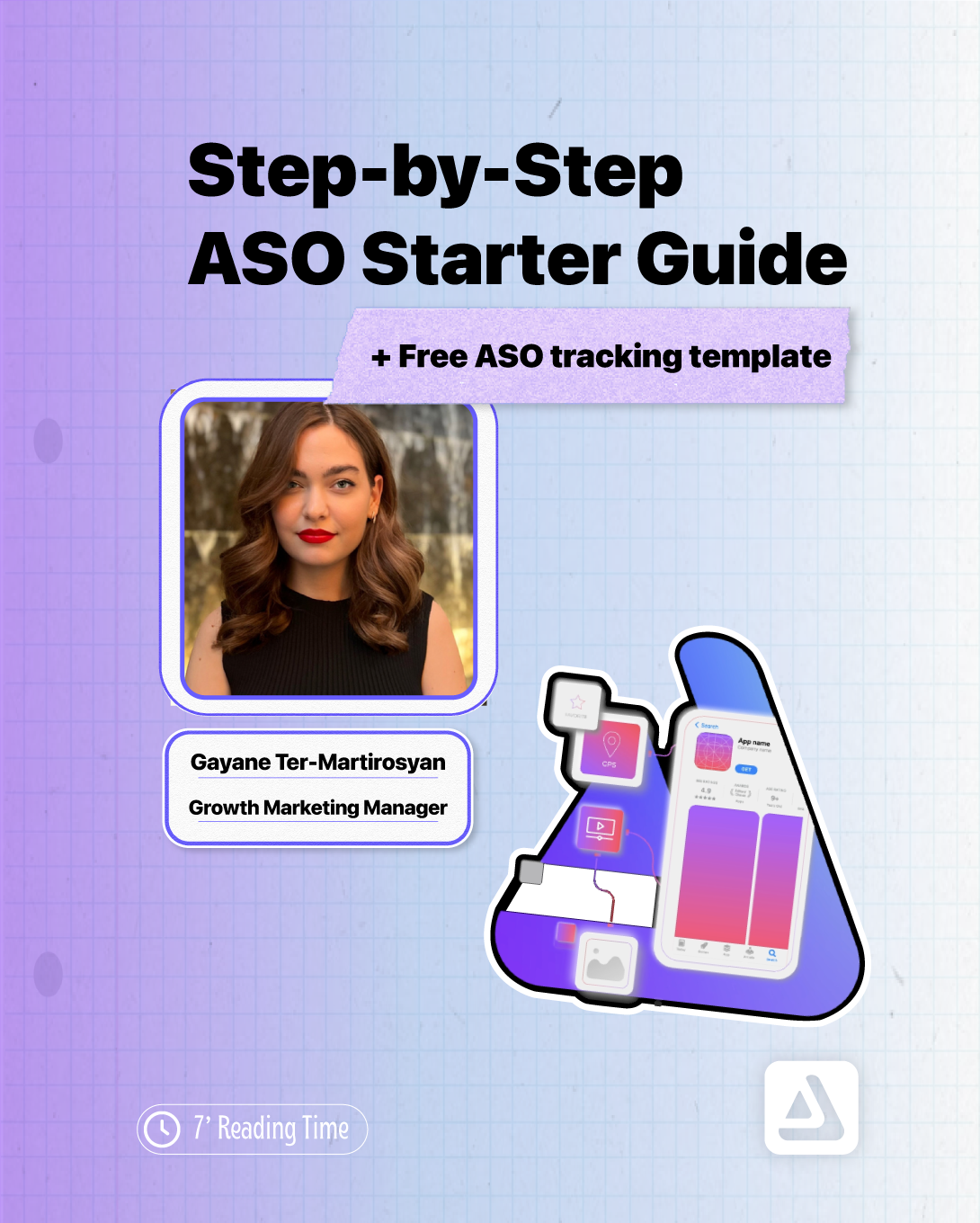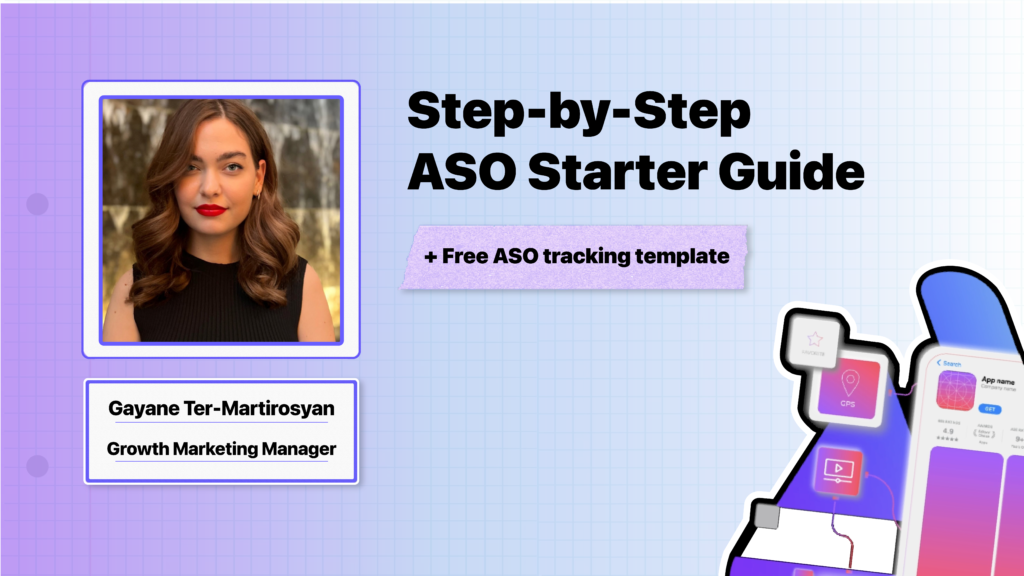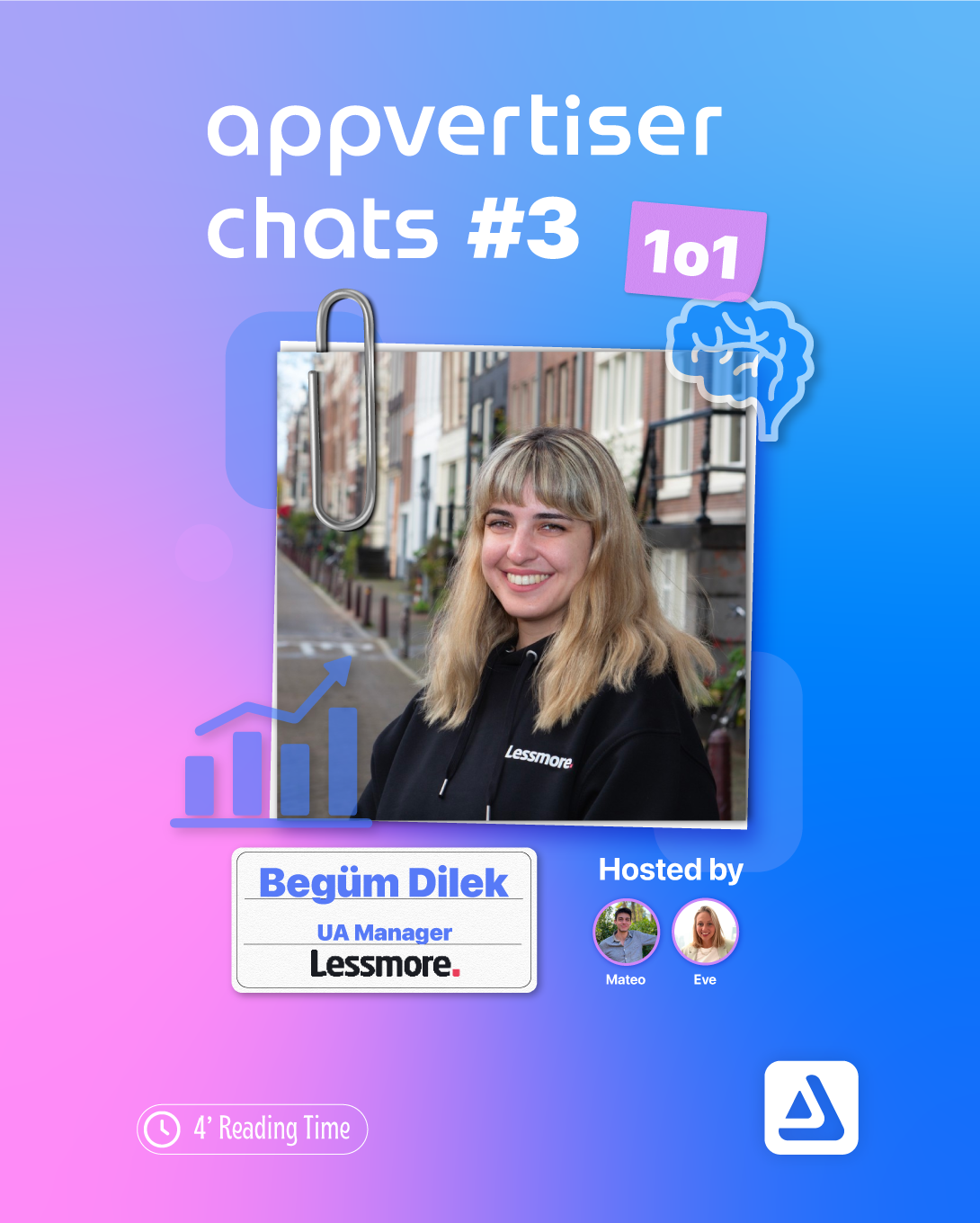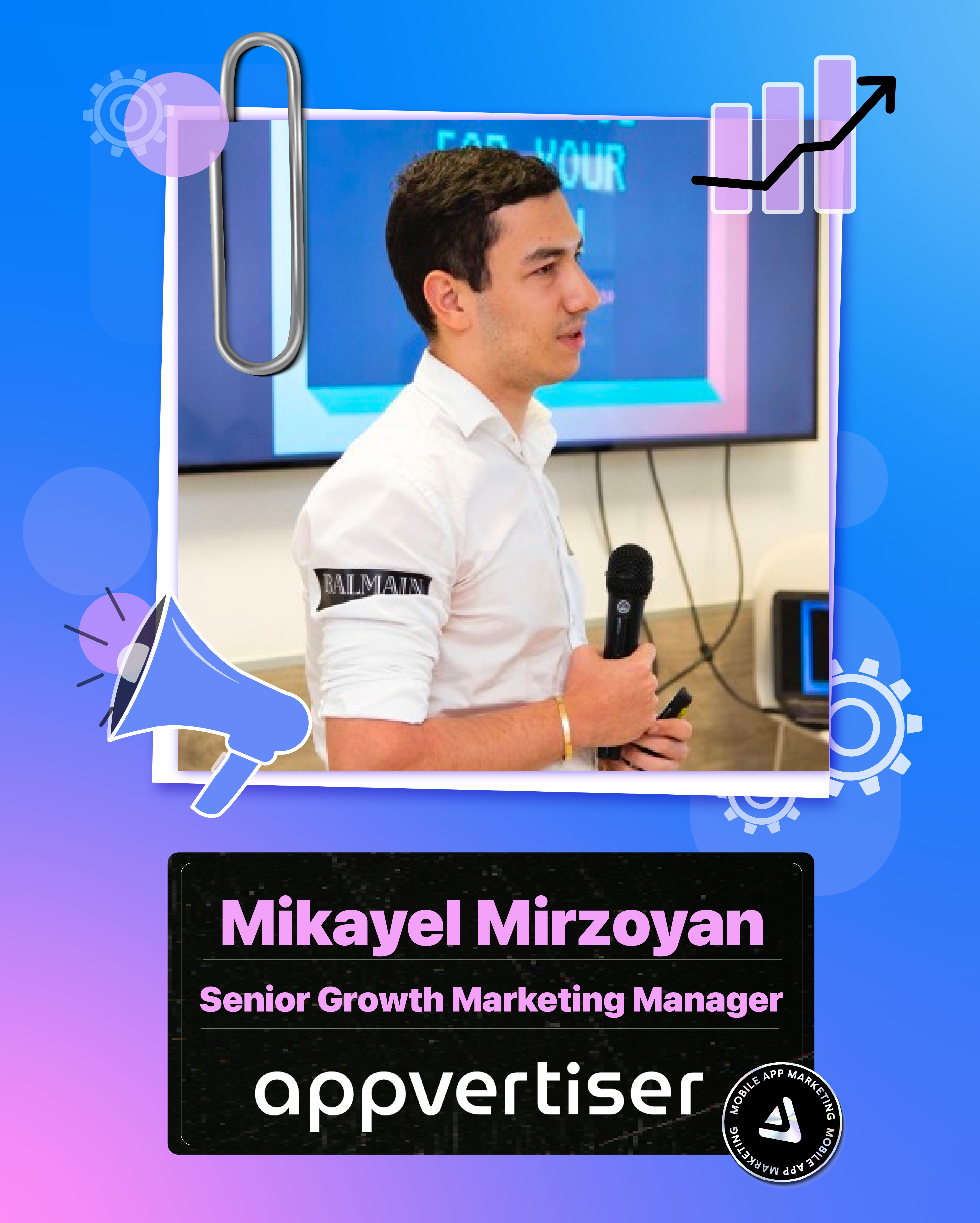
Step-by-Step ASO Starter Guide

Welcome to our guide to mastering App Store Optimization (ASO). In this section, we’ll take you through the initial steps of ASO research, setting the foundation for enhancing your app’s visibility and attracting organic downloads.
Here’s a free, easy-to-use template for you. We’ll use this later!
Step 1: Identify Competitors
To begin, pinpoint your app’s competitors—both direct and indirect. You can gather this information by consulting the client or conducting your research independently.
• Add your app to MobileAction: Use the Mobile Action platform, keeping in mind the targeted operating system (iOS or Android).

• Discover competitor suggestions: Once your app is added, Mobile Action will provide suggestions for competitor apps.
Step 2: Start tracking keywords
Keyword tracking is essential for understanding how users discover apps. Here’s how to get started:
• Access ASO report: Navigate to the ASO report section within Mobile Action.
• Search and collect keywords: Search for your app and collect all keywords, regardless of their search scores or relevance. Having a complete keyword list is the best option to have a full understanding.

Top charts offer valuable insights into trending apps. This step is crucial for gathering relevant keywords:
• Top charts analysis: Study the top apps within your app’s category. Focus on the keywords associated with these top-performing apps.
• Include keywords from top apps: Filter top apps by category and country. Select 1-10 apps that closely resemble your client’s app, and track their keywords using Mobile Action’s ASO report.
• Keyword intelligence: Pay attention to keywords driving traffic not only for competitors but also for your client. Prioritize keywords with search scores exceeding 30 for potential use in your new metadata.
Step 4: Collect current keywords
Don’t overlook the keywords that are already driving traffic to your client’s app:
• Gather current keywords: Collect all current keywords responsible for your client’s app traffic. These keywords can provide insights into potential opportunities for further optimization.
Are you liking this?
😏 Schedule a free aso consultation with us today
📚 Read related blogs
🔍 Visit our website and explore our solutions
Step 5: Export keywords and create research document
To organize your research effectively, exporting keywords and creating a dedicated research document is crucial:
• Export keywords as CSV: Export all keywords you’ve tracked from the keyword tracking section.
• Create a research document: Use a dedicated template (here’s a free one for you) for your ASO research. Separate documents for iOS and Android are necessary, as well as for different countries, to avoid confusion.
• Document structure: Begin by filling in the “current metadata analysis” tab, analyzing titles, subtitles, and keywords for iOS and Android.

Step 6: Analyzing current metadata
Analyze the current metadata and keywords you’ve gathered:
• Track keywords and combinations: Track keywords individually and then track combinations. For instance, if the app’s title is “TREBEL: Music To Listen To,” track keywords like music, listen, listen to music, listen music, music to listen to, and music to listen.
• Fill metadata analysis tab: Export the CSV file from your keyword tracking and use it to fill the “current metadata analysis” tab. Use factors like search scores, download impacts, and rankings to determine which keywords to retain and which to replace.
Step 7: Documenting current keywords and rankings
Documenting your app’s current keyword performance and rankings is also a must:
• Current keywords tab: Add all current keywords observed in the ASO report section. This information serves as a baseline to monitor changes after updates.
• Rank 1-10 keywords tab: Track keywords where your app ranks between 1-10. These keywords are highly important for optimization.
• Download distribution tab: Extract this data from Mobile Action’s keyword intelligence section.
Step 8: Competitor analysis for better understanding
Understanding your competition is vital in optimizing your app’s presence. Follow these steps:
• Competitor list tab: Fill in the competitor list tab with competitor names, search scores, and keywords. This helps you assess the competitive landscape and position your app among rivals.
• Mobile Action’s ASO report: Access the ASO report within Mobile Action. Search for each competitor app and gather data like search scores and keywords.
Appvertiser ASO & Organic Growth Solution
Step 9: Organize your keywords for ease
Efficiency is key. Organize your keyword research for streamlined analysis:
• Copy keywords to research document: Take the exported CSV from Mobile Action’s keyword tracking and paste all keywords into the research document’s mobile action tab.
• Copy keywords to KW tab: In the KW tab, copy only the keywords. A formula in this tab will automatically incorporate necessary data such as search scores and rankings.
• Why this process? This allows for easy filtering and keyword selection when brainstorming metadata options. Focus on keywords that are relevant to your app and boast search scores exceeding 30.
Step 10: Creating Metadata Options for Maximum Impact
With your organized keywords, it’s time to craft optimized metadata:
• Title and subtitle (or Short Description/Long Description): Prioritize keywords with the highest search scores in your title or subtitle. For iOS, ensure keywords within the keyword range contribute meaningfully. For Android, focus on incorporating keywords into the short and long descriptions.
• Keywords that drive downloads: Incorporate keywords that bring downloads, provided their search scores are higher than 30.
• High search scores and rankings: Give priority to keywords with high search scores and rankings, ideally within the top 1-15.
• Avoid certain terms: Refrain from using terms like “best,” “free,” “online,” and avoid numerical rankings like “top 1.” These terms can be counterproductive.
• Character limit and repetition: iOS titles can’t have more than 50% of characters changed for the main country. Avoid repeating keywords in iOS, but repetition is acceptable in Android.
• Comparing options and testing: Compare your metadata options and consider running A/B tests. Note that A/B testing for titles and iOS metadata requires a User Acquisition (UA) campaign with tools like GeekLab.
Step 11: Android-specific checkpoint
For Android, an additional step is necessary before metadata creation:
Keyword check in Sensor Tower: Use Sensor Tower, a very useful tool similar to Mobile Action, but optimized for Android. Log in and access the ASO section, specifically keyword rankings.
Sensor Tower Insights: Remember that you can track up to around 75 keywords at once, but take into account exporting CSV is not possible. Copy and paste data manually.

Filter relevant keywords: From your Mobile Action report, select only relevant keywords for tracking in Sensor Tower.
Rest of the process: Once you’ve tracked relevant keywords in Sensor Tower, the rest of the process remains similar to the iOS approach.
Download distribution on Android: Unlike Sensor Tower, Google Play Console provides data on keywords that drive downloads for Android. Access this data in Dashboard > Store Listing Acquisitions > Search Terms.
A/B Experiments: Optimizing Your App’s Presentation
A crucial aspect of successful ASO lies in running A/B experiments to refine your app’s visual elements and metadata. Let’s explore how to conduct these experiments effectively on both iOS and Android platforms.
iOS A/B Experiments:
In iOS, A/B testing primarily revolves around app icons, screenshots, and preview videos. Unlike Android, metadata testing (title, subtitle, keyword range) requires a third-party tool like GeekLab, where you run a User Acquisition (UA) campaign. Keep these points in mind:
1.Test approval and timing: Before launching a test, it undergoes Apple’s review process. If your preview assets are rejected, adjust and retry. During a live experiment, developers can’t release new updates, so coordinate timing. Tests usually run for 7-10 days and can’t launch if there’s a pending release version.
2.Creation: When creating a test, specify the country and components you’re testing. You can test up to 3 new components alongside your current one.
3.Traffic proportion and language: Traffic is usually equally distributed between components. Choose the language and store listing you want to test.
4.Indicator: Choose an improvement indicator for the algorithm to assess the experiment’s success.
5.Data analysis: After approval, monitor data for at least 7-10 days. It’s easy to interpret—new options’ performance is compared to the current store listing.
6.Pausing or applying treatment: Pause the experiment or apply the winning treatment for live use. Applying changes requires another Apple review.
7.A/B for icons: Launching A/B tests for icons is complex; it involves integrating new options with the app’s build. Refer to Apple’s tutorials for guidance.
Android A/B Experiments:
Google Play Console allows A/B testing for short and long descriptions, icons, screenshots, and preview videos. Google’s process is simpler due to a lack of strict review:
1.Test setup: Android testing mirrors iOS but without the stringent review phase.
2.Applying New Metadata: Access Google Play Console and navigate to the main store listing section to edit the app name, short description, and long description.
3.Managed publishing: Be aware of managed publishing settings; if enabled, changes need manual review and publishing to be visible to users.
Must-Knows in ASO
When diving into App Store Optimization (ASO), understanding the critical elements can make all the difference. Here are the key insights you need to grasp:
Metadata’s impact on visibility:
• Metadata, including titles, subtitles, keyword ranges, and descriptions, shapes your app’s visibility in app stores.
• iOS reveals the metadata’s effect within 7 days, while Android trends start showing after about 3-4 weeks.
• Tailor your keyword research for each platform, recognizing that effective keywords vary between iOS and Android, even within the same region.
Preview assets for conversion rates:
• Icons, screenshots, and preview videos are pivotal in driving higher conversion rates.
• Strategic optimization of these assets directly contributes to boosting your app’s download numbers.
Crafting with strategy:
• Maximize the potential of metadata components while staying within character limits.
• Clearly convey your app’s value to users through concise titles, impactful subtitles, and well-chosen keywords.
• On iOS, remember the 30-character limit for titles and subtitles, and the 100-character limit for keyword ranges.
• For Google Play, optimize within the 30-character title, 80-character short description, and crucially, the first 1-4 paragraphs of the 4000-character long description.
😏 Schedule a free aso consultation with us today
📚 Read related blogs
🔍 Visit our website and explore our solutions




